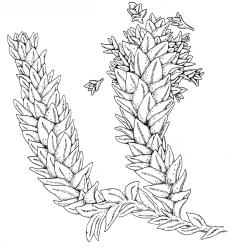The following generic description draws on that of Crum & Anderson (1981).
Plants small and slender, forming dull mats, mostly on bark. Stems irregularly branched. Stem and branch leaves similar, crowded, erect and imbricate when dry, spreading to squarrose when moist, broadly ovate to ovate-lanceolate, acute or acuminate, not plicate, usually weakly decurrent, entire or weakly toothed, plane at margins, concave or broadly V-shaped; mid laminal cells rounded-hexagonal or rounded-quadrate, smooth or mammillose, often oblate at basal margins but not forming a distinct alar group. Costa rather stout, ending below leaf apex. Paraphyllia lacking or few and foliose. Pseudoparaphyllia lacking. Propagulae (branchlets) often present in axils of upper leaves.
Autoicous. Perichaetial leaves pale, acuminate from a sheathing base. Setae elongate; capsules erect or weakly curved, oblong-cylindric, narrowed at mouth; annulus sometimes differentiated; operculum conic, blunt. Peristome inserted below mouth; exostome teeth lanceolate, blunt, fused at base, pale or yellow, ± papillose, not striolate, with low trabeculae on inner surface at base; endostome a low, finely papillose membrane. Calyptra smooth, naked. Spores small, smooth or roughened.
Lindbergia is a genus of between 10 and 20 species distributed in temperate and tropical regions. One species is accepted from N.Z., and a second very poorly documented taxon may also be referable here.
| Category | Number |
|---|---|
| Indigenous (Endemic) | 1 |
| Total | 1 |
A single sterile specimen from Canterbury (Hunters Hills, Blue Cliffs Station, Homestead, on soil in podocarp-broadleaf remnant in gully, 800 ft. elev., B.H. Macmillan 76/288, CHR 351347) has been tentatively referred to Lindbergia. The mid laminal cells here are more angular and less incrassate and the alar cells are quadrate in a rather small group compared to those of L. brachyptera. The apparently dioicous sexuality and the soil substrate are also anomalous for the genus Lindbergia. It may represent an undescribed species; a draft description follows.
Plants irregularly to subpinnately branched, ascendant, possibly stoloniferous. Stems mostly c. 10 mm; branches mostly simple, 5–10 mm. Stem and branch leaves differentiated by size and degree of cell papillae development. Stem leaves ovate-lanceolate, serrulate near apex, neither constricted nor decurrent at base, narrowly recurved, c. 1.2 mm; mid laminal cells oblong-hexagonal, mostly 1–2:1 and 9–15 µm long and a single strong papillae over the central lumen; alar cells quadrate in a small and ill-defined group; costa strong, percurrent or shortly excurrent. Branch leaves arranged in 4–5 rows, loosely and rather untidily complanate, mostly 0.6–0.8 × c. 0.25 mm; mid laminal cells with a single high (c. 6–10 µm) central papilla on each surface; costa strong, c. 25 µm wide in lower leaf, not flexuose, ending in the leaf apex, strongly papillose abaxially. Paraphyllia absent.
Apparently dioicous. Perichaetia terminal on stem, the leaves differentiated, linear-lanceolate, c. 3.5 mm, costate, with cells weakly and single papillose. Perigonia and capsules not seen.




